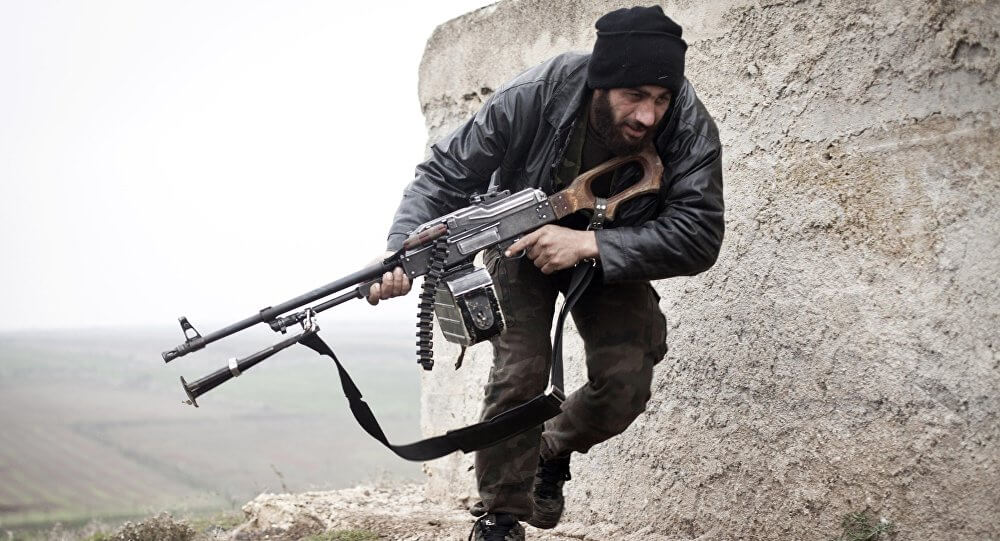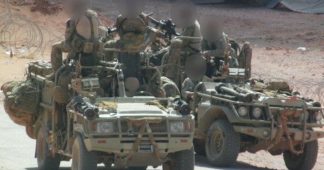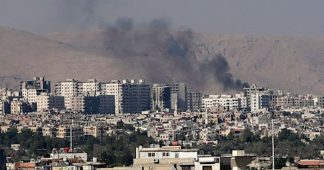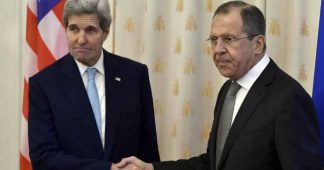How the White Helmets Became International Heroes While Pushing U.S. Military Intervention and Regime Change in Syria
Created by Western governments and popularized by a top PR firm, the White Helmets are saving civilians while lobbying for airstrikes.
By Max Blumenthal
The following is Part 2 of a two part investigation into the forces cultivating Western public support for regime change in Syria. Read Part 1here.
It is rare for a short Netflix documentary to garner as much publicity or acclaim as The White Helmets has. Promoted as “the story of real-life heroes and impossible hope,” the film is named for the civil defense organization whose members have gained international acclaim for saving lives in rebel-held territory in the hellish war zones of eastern Aleppo and Idlib. The film’s tagline, “To save one life is to save all of humanity,” that is remarkably similar to that of Steven Spielberg’s Holocaust epic, Schindler’s List: “Whoever saves one life, saves the world entire.”
The Netflix feature comes on the heels of a Nobel Peace Prize nomination for the White Helmets, an “alternative Nobel” award known as the Right Livelihood Award and endorsements from an assortment of celebrities. “The move [by the celebrities] draws attention to both the horror of the conflict and the growing willingness of well-known Americans to adopt it as a cause célèbre,” wrote Liam Stack of the New York Times.
Footage of the White Helmets saving civilians trapped in the rubble of buildings bombed by the Syrian government and its Russian ally has become ubiquitous in coverage of the crisis. An international symbol of courage under fire, the group has become a leading resource for journalists and human rights groups seeking information inside the war theater, from casualty figures to details on the kind of bombs that are falling.
The bravado displayed by the White Helmets under Syrian government and Russian bombardment has captivated some of the most influential observers of the Syrian conflict. Among the group’s biggest boosters is Sophie McNeill, the Australian Broadcasting Corporation correspondent who was among the first reporters to publish the now-famous photo of 5-year-old Omran Daqneesh being extracted from the rubble of an Eastern Aleppo apartment building.
On her Twitter account, McNeill urged readers to donate money to the White Helmets and expressed her hope that the group wins the Nobel Prize. (McNeill did not respond to questions sent to her publicly listed email.) Laura Rosenberger, a foreign policy adviser to Hillary Clinton, also took to Twitter to promote the group, posting a Wall Street Journal article hailing the civil defense group as “white knights for desperate Syrians.” Hillary Clinton quickly retweeted Rosenberger, registering her own tacit endorsement of the White Helmets. On September 22, Secretary of State John Kerry declared that he was “honored to meet [the White Helmets] leader and Aleppo activists,” hailing the organization as “brave 1st responders on the scene.”
The White Helmets are touted for saving tens of thousands of lives, though estimates on exactly how many varies dramatically depending on the source. The recently released White Helmets’ Netflix documentary claims they’ve saved “over 55,000” people, while Georgetown Security Studies Review had the number at 15,500 in May 2015. The State Department claimed this April that 40,000 had been rescued by White Helmets, but AJ+, a subsidiary of Al Jazeera, asserted around the same time that “more than 24,000” have been saved.” In a separate report published four months later, AJ+ quoted the figure at 60,000—which is the figure the White Helmets themselves claim. Whatever the number, there is little dispute that the White Helmets’ rank-and-file are saving lives in what seems to be an increasingly desperate situation in eastern Aleppo.
Yet the group is anything but impartial. The White Helmets’ leadership is driven by a pro-interventionist agenda conceived by the Western governments and public relations groups that back them. Anyone who visits the group’s website—which is operated by an opposition-funded PR company known as the Syria Campaign—will be immediately directed to a request to sign a petition for a no-fly zone to “stop the bombs” in Syria. These sorts of communiques highlight the dual role the White Helmets play as a civil defense organization saving lives while lobbying for a U.S. military campaign that will almost inevitably result in the collapse of Syria’s government.
According to a 2012 Pentagon estimate, a no-fly zone would require at least “70,000 American servicemen” to enforce, along with the widespread destruction of Syrian government infrastructure and military installations. Also sometimes called “safe zones” or “buffer zones,” from Yugoslavia to Iraq to Libya, no-fly zones have served almost without exception as the preamble to regime change. With no clear plan in place for the day after the government falls, or any conclusive evidence that its ouster is what most Syrians want, the Western governments, professional activists and public relations specialists who created the White Helmets are intensifying their push for regime change.
The White Helmets were founded in collaboration with USAID’s Office of Transitional Initiatives—the wing that has promoted regime change around the world—and have been provided with $23 million in funding from the department. USAID supplies the White Helmets through Chemonics, a for-profit contractor based in Washington DC that has become notorious for wasteful aid imbroglios from Haiti to Afghanistan. While members of the White Helmets have been implicated in atrocities carried out by jihadist rebel groups, the names of many of the firms that supposedly monitor and evaluate their work have been kept secret by USAID on unspecified security grounds.
Away from the battlefield, the White Helmets have proven one of the most effective tools in the Syria Campaign’s public relations arsenal. Apart from the group’s own calls for a no-fly zone, the White Helmets have been at the center of the Syria Campaign’s ongoing attack on the United Nations, which it accuses of illicit collusion with Assad. This month, the White Helmets joined 74 other groups operating in rebel-held territory announced their refusal this month to cooperate with the U.N. as long as it recognizes the Syrian government. In a separate move, the Syria Campaign launched a petition to demand that the United States National Security Council share confidential radar information with White Helmets teams operating on the ground, apparently including in areas controlled by extremist rebel factions.
In May 2015, White Helmets spokesperson Raed Saleh met privately with U.N. and EU officials to push for a no-fly zone. A month later, Saleh’s colleague Farouq Habib testified before the U.S. House Committee on Foreign Affairs in support of a no-fly zone, claiming to possess first-hand knowledge of chemical weapons attacks by the Syrian government. With the Obama administration having drawn its “red line” at the deployment of chemical weapons, allegations like these are potential trigger points for full-scale U.S. military intervention.
The White Helmets’ Netflix documentary studiously avoids any discussion of the group’s interventionist, hyper-partisan agenda and omits any mention of its actual origins among Western governments, leaving the impression that the White Helmets are an organically developed band of politically impartial volunteers reflecting the Syrian consensus.
Critical questions about the White Helmets’ role in an interventionist public relations apparatus have been raised by only a few marginal websites that generally support the Syrian government — and those who raise them have been subjected to scorn and castigation. Thus the issue has been kept off the table, along with the public debate over the consequences of a regime change policy that the Obama administration still supports.
The White Helmets in Washington
This September 27, while White Helmets members dug survivors and bodies from the ruins of buildings in the rebel-held warzone of eastern Aleppo, two of the group’s public representatives appeared in Washington for a series of events and high-level meetings. The first event open to the public was held at the Atlantic Council, an influential think tank with close ties to the Obama administration, and took place under the banner of the Rafik Hariri Center for the Middle East, which is named for and funded by the family of the assassinated former Lebanese Prime Minister who amassed his fortune through business ties to the Saudi royal family. (Rafik’s son, Saad, blames the Syrian government for killing his father and creating ISIS and has effectively called for its removal.)
Presiding over The White Helmets reception was Frederick Hof, the director of the Hariri center, a former adviser to Hillary Clinton on Syrian “transition” and a longtime State Department envoy in the Middle East. Hof has said his focus on Syria at the State Department was motivated by the prospect of “beating Hezbollah and its Iranian master,” a goal he found “inspiring.” As he introducedThe White Helmets, Hof accused Syrian president Bashar Al-Assad of committing war crimes with impunity and demanded that his government pay a “heavy price.”
While conceding that a no-fly zone was not a feasible option because it would subject the U.S. Air Force to Syria’s anti-aircraft systems, Hof told me he preferred cruise missile strikes against Syrian military installations and arming the rebels with Manpad shoulder-mounted anti-aircraft missiles. When I asked if he feared such sophisticated weapons falling into the hands of Jabhat Fateh Al-Sham or Ahrar Al-Sham, the jihadist groups that boast the most manpower and battlefield prowess, Hof accused me of ignorance about the Defense Department’s foolproof vetting mechanisms.
After a screening of the trailer for The White Helmets, Hof introduced the civil defense group as a heroic and absolutely “impartial” party to the conflict. He then welcomed Saleh, the White Helmets spokesman, to the stage. “Our demand is not for support to continue the work of the White Helmets, rather our demand is to stop the killing itself so that we don’t have to continue this awful job,” Saleh said.
Seated beside Saleh and providing live translation was Kenan Rahmani, a legal and strategy adviser to the Syria Campaign. As I reported in Part 1 of this series, the Syria Campaign is a private company founded by a New York- and London-based public relations firm called Purpose in order to generate public pressure for the removal of Syria’s government. It led the push for the White Helmets’ Nobel Prize nomination, orchestrated the group’s endorsements from Hollywood celebrities and has fundraised for its Netflix documentary vehicle.
Rahmani, for his part, was a policy adviser to the Coalition for a Democratic Syria, a umbrella organization of exile groups with close ties to the Syrian rebels and neoconservative organizations in Washington, before he took his current job at the Syria Campaign. When I asked Saleh how the White Helmets’ demand for a no-fly zone fit with its claim to uphold impartiality, Rahmani interjected to defend his company’s work.
“Of course we are an impartial, non-political organization,” he said. “The Syria Campaign doesn’t take political sides but our position is a no-fly zone would stop the suffering, would stop the destruction.” Saleh of the White Helmets followed up with his own call for a no fly zone, telling me that if I understood the scale of destruction in Syria, I would agree with his demand.
Moments after the panel discussion ended, Rahmani approached me to complain about my line of questioning. “These people [the White Helmets] are saving lives,” he began. But before he could complete his sentence, Rahmani was whisked away by Anna Nolan, the Purpose firm’s director of strategy who oversaw the Syria Campaign’s foundation. From that point on, Rahmani refused to speak to me.
Seated in the front row throughout the event was Ayman Asfari, one of the main funders of the Syria Campaign and a top exile supporter of the Syrian opposition. The billionaire CEO of the petroleum services company Petrofac, Asfari contributed $180,000 of the Syria Campaign’s $800,000 budget this year. (Most of the company’s donors are anonymous.)
I approached Asfari on his way out to ask how long he planned to continue directing his fortune toward promoting regime change. “There is a political process, which is a transition. We just want to bring back the transition,” he said before disappearing into an elevator. In a few hours, Asfari would host a screening of The White Helmets at the Carnegie Endowment for International Peace.
The White Helmets’ founding fathers
Supporters of heightened U.S. military intervention in Syria routinely accusePresident Barack Obama of not doing enough to support the forces fighting the Syrian government. James Traub, a leading liberal voice of interventionism, hasrepeatedly claimed over the past five years that the U.S. is “doing nothing” in Syria and paying a terrible price for it. But together with the $1 billion the CIA has spent on arming and training the rebels, a close look at the hundreds of millions of dollars the U.S. Agency for International Development has spent in Syria on projects including the White Helmets tells a different story.
Back in July 2012, a year after the Syrian conflict began, USAID began to lay the groundwork for its Syrian Regional Option. With American analysts excitedly proclaiming the imminent downfall of Bashar Al-Assad and his government, USAID rushed to “provide support to emerging civil authorities to build the foundation for a peaceful and democratic Syria,” according to a USAlD executive report from that year.
The grants were authorized by USAID’s Office of Transitional Initiatives (OTI), spearheading efforts to encourage what proponents like to call “democracy promotion” in countries like Cuba and Venezuela, but which amount to failed attempts at regime change. In Cuba, USAID’s OTI caused an embarrassing diplomatic incident in 2014 when it was exposed for funding a program aimed at spawning instability and undermining the government through a Twitter-like social network called Zunzuneo.
Following a series of pilot programs carried out by a for-profit, Washington DC-based contractor called Development Alternatives International (DAI) at a cost of $290,756 to U.S. taxpayers, the OTI began setting up local councils in rebel-held territory in Syria. The idea was to establish a parallel governing structure in insurgent-held areas that could one day supplant the current government in Damascus. According to its 2012 USAID executive summary on the Syria Regional Option (PDF), “foreign extremist entities” already held sway across the country.
In March 2013, a former British infantry officer named James Le Mesurier turned up on the Turkish border of Syria. Le Mesurier was a veteran of NATO interventions in Bosnia and Kosovo who moved into the lucrative private mercenary industry after his army days ended. But running security for the UAE’s oil and gas fields left him feeling unfulfilled with his career as a hired gun. He wanted to be a part of something more meaningful. So he became a lead participant in USAID’s Syria Regional Option.
Le Mesurier’s job was to organize a unique band of people who rush into freshly bombed buildings to extract survivors—while filming themselves—in rebel-held areas facing routine bombing by Syrian army aircraft. In 2014, he established Mayday Rescue, a non-profit based in Turkey that grew out of the Dubai-based “research, conflict transformation, and consultancy” firm known as Analysis, Research, and Knowledge, or ARK. That group, which employed Le Mesurier while overseeing the White Helmets’ training, has been sustained through grantsfrom Western governments and the British Ministry of Defense. Mayday Rescue, for its part, received around $300,000 in initial funding from the U.S. Department of State to assist in training the first responders. Though they were known as Syrian Civil Defense, graduates of Le Mesurier’s course became popularly identified by the signature headgear they wore in the field: White Helmets.
Since being founded under the watch of Mayday Rescue, the White Helmets have received grants worth millions of dollars from the U.K. Foreign and Commonwealth Office, Japan and USAID. To date, USAID has donated $23 million to the White Helmets, a substantial sum for a civil defense project in a war zone.
Mark Ward, director of the Syria Transition Assistance and Response Team at the State Department, highlighted the political dimension of the White Helmets’ funding in an interview with Men’s Journal: “[Funding the White Helmets is] one of the most important things we can do to increase the effectiveness and legitimacy of civil authorities in liberated areas of Syria.”
In the Netflix documentary The White Helmets, Mayday Rescue is never identified as the administrator of the group, nor does Le Mesurier ever appear on screen. USAID and Chemonics, the for-profit contractor that supplies the group, are also curiously omitted from the film.
An unmonitored money dump?
USAID relies on Chemonics to deliver resources to the White Helmets. The company’s contract with the group is part of the $339.6 million committed by USAID for “supporting activities that pursue a peaceful transition to a democratic and stable Syria.” This whopping sum of money supplements the reported $1 billion the CIA spent in the past year supplying and training the rebel forces attempting to overthrow the Syrian government, fueling a grinding civil war that necessitates the presence of thousands of first responders.
Based in downtown Washington DC, Chemonics has developed a checkered history across the world. In Haiti, the company squandered millions of U.S. taxpayer dollars and delivered next to nothing for average Haitians while racking up a $2.5 million bonus for its CEO. Jake Johnston, a research associate at the Center for Economic and Policy Research, produced a series of reports exposing Chemonics’ disastrous performance in Haiti.
“After the 2010 earthquake in Haiti, Chemonics was the recipient of the largest single contract from the U.S. government. But despite the immediate and grave humanitarian needs, funding for Chemonics came from the Office of Transition Initiatives, the ‘political arm’ of USAID,” Johnston told me. “Rather than basing funding decisions on the needs on the ground, OTI provides funding based primarily on U.S. national interests and to help steer political transitions across the globe.”
Johnston pointed to a lack of independent monitoring procedures as one of USAID’s most substantial failures. “Unfortunately, it becomes extremely difficult to track where money spent by OTI and Chemonics actually ends up,” he said. “Programs are designed to be broad, flexible and fast, distributing millions of dollars to subcontractors with very little public oversight or accountability.”
In reports by the U.S. Government Accountability Office and USAID Inspector General, Chemonics was slammed for its incompetent performance and poor evaluation procedures, and was accused of wasting tens of millions of dollars in Afghanistan.
For many languishing in rebel-held territory in Syria, however, USAID and its contractors are among the only sources of sustenance. As Brett Eng and Jose Ciro Martinez wrote in Foreign Policy, USAID’s involvement in Syria “has created another unhealthy form of dependence in opposition-controlled areas like Daraa. Instead of the Assad regime, it is the United States, Jordan, and the for-profit development organization Chemonics that civilians in Daraa are beholden to.”
Eng and Martinez also warned that USAID might be inadvertently propping up some of the more unsavory rebel factions, writing, “without a well-defined, inclusive opposition group, it is unclear to whom civilian loyalties are being redirected.”
Frankie Sturm, a public information officer at the State Department, told me that Chemonics “has put in place third-party monitors to verify that assistance reaches intended beneficiaries and for intended purposes.”
When I asked Chemonics for the names of these monitors, it directed my questions back to USAID, which refused to provide an answer on security grounds. USAID spokesperson Sam Ostrander told me his agency “works with another firm, completely separate from Chemonics” to monitor the assistance to the White Helmets, but didn’t name the company or disclose how much public funding it received.
In 2014, USAID produced the only evaluation report to date on its Syria-related “transition initiatives.” It was not exactly a portrait of success. “The extent to which OTI’s efforts were successfully building inclusive and accountable governance structures was still unclear,” the report concluded, also noting that “the ongoing conflict resulted in challenges that have led to delays in development and implementation of these activities.”
With such thin monitoring mechanisms in place to track how USAID money is spent in Syria, the risk of misappropriation is considerable.
‘Emergency burial’
Far from the gaze of most Western media consumers, videos and photographs have surfaced on news sites and social media accounts sympathetic to the Syrian government showing White Helmet members boasting about discarding the body parts of Syrian troops in dumpsters, posing triumphantly on the corpses of Syrian soldiers, joining fighters accosting an alleged political opponent, waving the flag of Al Qaeda affiliate Jabhat Al-Nusra alongside jihadist fighters, and carrying weapons.
While it would seem unfair to tar an entire group with the actions of a few scofflaws, more than a few of the images depict events that are disturbingly real. One particularly jarring video (18+) filmed in Northern Aleppo shows two members of the White Helmets participating in an execution, waiting just off camera while a member of Al-Nusra shoots a man dressed in street clothes in the head after reading out a death sentence. The video of the two White Helmets members immediately packing up the man’s body prompted a statement by the organization condemning the killing and claiming its members were simply fulfilling their task to perform “the emergency burial of the dead.”
In May 2015, a White Helmet member named Muawiya Hassan Agha providedan extensive eyewitness account to the Violations Documentation Center in Syria on the alleged deployment of chemical weapons by Syrian government warplanes in Idlib. (The report described him as a “media activist.”) A year later, Agha was exposed by pro-government social media activists for filming a grotesque video depicting extremist Syrian rebels torturing two captured soldiers they later executed. EA Worldview editor-in-chief Scott Lucas reportedthat Agha was expelled from the White Helmets days later.
Asked about the allegations of involvement by White Helmet members in human rights violations, the State Department’s Sturm replied, “Syria Civil Defense are emergency response workers who risk their lives to save others—men, women and children trapped by the ravages of war. USAID has no credible information to believe the organization is engaged in anything other than this core mission.”
Chemonics refused to offer a comment on its monitoring and evaluation of the White Helmets or other clients in Syria.
Syria Campaign hones the message
In 2014, the year after USAID disbursed its seed money for the White Helmets, an outfit called the Syria Campaign suddenly materialized to mobilize even greater support for Western intervention through online “clicktivism.” Among the group’s primary functions has been marketing the White Helmets to Western media consumers as non-political heroes saving lives in a sea of sectarian villains.
“We went to meet [the White Helmets] at a training in southern Turkey, they were focused on the training and we were like, we’d like to elevate you guys and get the inspiring work you do out to the world,” James Sadri, campaign director at the Syria Campaign, told me.
Back in November 2014, Tim Dixon, the managing director of Purpose Europe, a former adviser to Australian Prime Minister Kevin Rudd and an original Syria Campaign board member, issued a report detailing how his firm’s “White Helmets campaign uses compelling storytelling to mobilize public support.” Dixon wrote: “Purpose believed their story had the power to inspire empathy and action in the wider public, and launched the White Helmets campaign in August as part of an ongoing effort to build support for the protection of civilians.”
Crediting the Syria Campaign’s promotion of the White Helmets with “significant breakthroughs on public engagement, media narratives, and funding,” Dixon boasted of “elite meetings in New York and DC” as well as coverage in outlets from the BBC to the New York Times. Among the most effective storytelling vehicles, according to Dixon, was the “Miracle Baby” video portraying the dramatic rescue of baby Mahmoud from beneath the rubble of a bombed-out home by a White Helmets team.
The episode featured prominently in the documentary The White Helmets and even included a cameo appearance by Mahmoud himself, now a toddler. The Netflix film appears to be at least partly the handiwork of the Syria Campaign.
This July, staffers of the PR company appeared in the studios of Channel 4 in London at a gathering of wealthy donors known as the Funding Network. “The Syria Campaign made a fantastic pitch for funding for their outreach work surrounding The White Helmets,” the Funding Network reported. The group noted, however, that “for reasons of confidentiality, we are unable to post the Syria Campaign’s pitch for the time being.”
Laila Kiki, the Syria Campaign’s media lead, told me, “We didn’t raise any funds specifically for outreach around the Netflix documentary, but our team is supportive of the release.”
On September 30, as the attacks on the rebel-held areas of Aleppo reached a level of unprecedented ferocity, the Syria Campaign sent out an email and social media blast in the name of “Heroes of Syria” like the White Helmets. The message urged supporters into the streets for a “weekend of action” to clamor for a no-fly zone—or what the PR company euphemistically described as, “all aircraft dropping bombs on civilians grounded.”
“In solidarity please cover your face in dust and share it with your friends on social,” the Syria Campaign advised. “If you can do this with a friend or family member, even better.”











